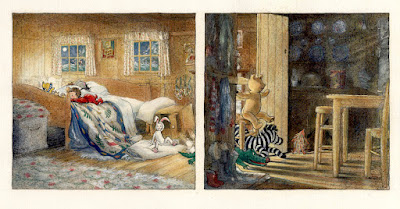This month, to celebrate the 30th anniversary of Ten in the Bed by Penny Dale, we are delighted to welcome Penny to the Illustrationcupboard blog to tell us ten quite interesting things you probably didn't know about this much-loved classic...
Words by Penny Dale:
The
idea for Ten in the Bed actually crept up on me while I was working
on something else.
I had always wondered
about the Ten in the Bed song when I sung it as a child. Who was the
little one? Why were the others being systematically ejected from the
bed? Who were they? It still perplexed me, and I thought it would be
interesting to try to answer the questions.
When developing ideas I
found I was thinking of it like a film, and as well as making a
storyboard which I always do, I worked it out with my editor in terms
of, scenes, continuity, character action and resulting positions…
Keeping track of ten
characters was tricky. I wanted the point of view to change on every
page zooming in and out, having high (elephant) and low (mouse)
points of view. I wanted a dark indoors at dusk, low firelight
atmosphere, and a lead character that behaved like real child, with a
parental presence hinted at by details, but not visible in the room
during the action.
So that was the
starting point.
Although the following
10 things are mostly about the illustrations - the blog piece is for
the Illustration Cupboard Gallery after all - there’s one thing
that is central to the text, which is the use of onomatopoeia. The
main subjects for most of the pictures were the surprise ‘landings’,
and the comic sounds that accompanied them. Children love a pause,
and then a sound to go with a sudden action. So that’s where the
text is focused. Also running underneath, throughout I hope, is the
feeling, despite the calamities, of belonging to a gang, a group… a
family.
Here follows ten quite
interesting facts about making the book:
1
——
Much of the inspiration for Ten in the Bed came from film and
animation. The book starts a bit like a film.
Sets the scene.
Zooms in to look through one of the windows.
Zooms in again to show everyone in the bed, and the story begins…
2
——
An illustrator friend noticed the action flowing right to left on
early roughs.
"Might
be good to flip everything so flow goes left to right? Um...in the
direction you turn page?"
Where would we be without observant friends?
3
——
I made a plan to work out positions in the rooms and
an extruded a 3D wire drawing so I could
work out POV.s of walls, windows, doors and furniture.
This is because I can imagine a scene once, but struggle to place everything
when viewing it from another direction.
4
——
The child was based on a combination of my toddler daughter
and a friend’s son. People have said the child reminds them of
their daughter, others their son, which is great, because I wanted
the child to be identified with by whoever happened to be reading the
book.
5
——
Colour was inspired by early 20th century animated films, where there
are particular dark reds, blues and golds, and even darker colours
within shadows. I masked light areas and used a toothbrush to flick
and stipple watercolour into the shadows.
6
——
The publisher, Sebastian Walker sometimes strolled about the office,
to see what was going on.
He
approached in his quiet way during a final editorial meeting, where
we were checking through the finished artwork, and said, ”My dear,
do be careful not to make it too dark.”
Thankfully he was looking at the very darkest illustration, on the
top of the pile, and probably didn’t know the rest were already
finished!
7
—
This illustration is an example of unwitting homage and borrowing of
ideas.(13 ,14) I know I loved the illustrations by E.H. Shepard, for
A.A. Milne’s Winnie-the Pooh as a child. I still do. Here is
evidence.
8
——
The quilt on the bed featured on nearly every page. I tried
many plain and patchwork variations. None worked.
so I decided to
design one from scratch. Then painted it onto a handkerchief, so I
could see how pattern folded etc.
9
——
The house was based on one featured in ‘The Coalminer’s
Daughter’ (film 1980) Dir. Michael Apted) and drawn while watching
the film on TV.
10
———
While in the early stages, we realised we would need more than the
usual 12 spreads of a picture book, to get everyone out… and then
back into bed. The red rectangles here, from the storyboard show the
plotting of an extra 2 spreads. And getting in again!
Ten in the Bed has sold nearly 2 million copies and has been heralded as one of the most popular picture books of recent decades. To celebrate its 30th Anniversary, Illustrationcupboard are currently hosting an exhibition of the original artwork, including entire matching series of working drawings and other reference material. See an artwork preview and discover more about the exhibition on our website.
——
WIN!
We have three signed copies of Ten in the Bed by Penny Dale available to give away! To enter, just answer this question...
In Ten in the Bed by Penny Dale, who
gets a ride in the potty?
To enter, just email your name, address and answer to gallery@illustrationcupboard.com with 'Penny Dale Competition' in the subject line before 1st May 2018. Good luck!






















